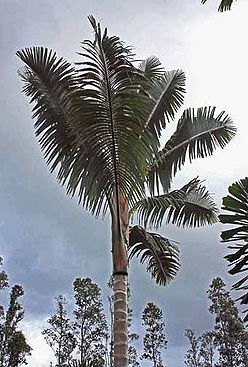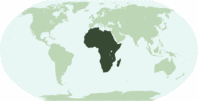Orania ravaka
| Orania (oh-rahn-EE-ah) ravaka (rah-VAH-kah) | |||||||
|---|---|---|---|---|---|---|---|
 Floribunda Palms, Hawaii. Photo by Paul Craft. | |||||||
| Scientific Classification | |||||||
| |||||||
| Synonyms | |||||||
|
| |||||||
| Native Continent | |||||||
|
| |||||||
| Morphology | |||||||
| |||||||
| Culture | |||||||
|
| |||||||
| Survivability index | |||||||
|
| |||||||
| Common names | |||||||
|
| |||||||
Contents
Habitat and Distribution
Endemic to Madagascar, mostly in the eastern part of the island facing the Indian Ocean. Varying from lowland up to rather highland tropical rainforest from about 80 up to 550 m above sea level. (A.P. Keim and J. Dransfield. 2012). Ridge crests on the north coast. Dransfield & Beentje (1995) reported the presence of the species on Île Sainte Marie, an island just off the northeast coast of mainland Madagascar, but no specimen has been collected so far. (A.P. Keim and J. Dransfield. 2012)/Palmweb.Description
Large palm. Trunk about 10 - 20 m tall, grossly swollen at base, about 10 - 20 cm in diam. at breast hight, internodes 2.5 - 5 cm, greyish brown, obscurely ringed with scars, bark pale brown. Leaves 6 - 8 in the crown ? some old individuals with 9 - 13, distichously arranged, densely covered with red-brown tomentum, about 2.5 - 4.5 m long; leaf-sheath about 21.5 - 35 cm long, 8.5 - 11 cm wide, margins disintegrating into fibres, in some individuals rarely, adaxial surface with thin red-brown tomentum, wax present, abaxial surface with dense red-brown tomentum and creamy white indumentum, sometimes with greyish white indumentum; petiole about 30 - 94 cm long, about 1.7 - 2 cm in diam. in the middle, margins disintegrating into fibres; rachis about 198 - 321 cmlong, about 2 cm in diam. in the middle; leaflets elongated lanceolate, regularly arranged leaflets held in one plane, about 33 - 44 on each side of rachis, leaflets about 5.5 - 7 cm distant, in the proximal about 3 cm, about 50 - 74 cm long, 4 - 5 cm wide, adaxial surface glabrous with white substance scattered, thin red-brown tomentum on basal part and midrib, greyish white indumentums on midrib, midrib robust, other ribs thick, abaxial surface with dense white indumentum and thin redbrown tomentum, midrib robust, other ribs thick; ramenta present, mainly on midrib, sparsely on other ribs, red-brown or dark brown, conspicuous, about 1 cm long.| read more |
|---|
| Inflorescence spreading, about 100 cm long, branching to 2 orders, robust; prophyll hard, persistent, margins adaxially disintegrating into fibres, about 26.5 - 32 cm long, 3.5 - 8 cm wide, adaxial surface glabrous, abaxial surface deeply covered with red-brown tomentum; peduncle curved, about 60 cm long, with dense red-brown tomentum, wax present; peduncular bract one or two, woody, about 45 - 62 cm long, 9 cm wide, adaxial surface glabrous, abaxial surface deeply covered with redbrown tomentum; rachis about 40 cm; first order branches 13, about 4 - 9 cm long each, rachilla bracts minute, in some individuals conspicuous, about 1.5 cm long, 0.8 cm wide; rachillae robust, about 26 - 40 cm long each, bearing 54 - 78 flower clusters, triads arranged in the proximal 1=5 part, the basal about 2.5 - 3.5 cm devoid of flowers, triads about 1.5 - 3 cm distant, rachilla glabrous, number of triads in rachilla 1 - 3. Staminate flowers with calyx of 3 united minute sepals; corolla creamy white, with 3 free petals, about 9 - 15 mm long, 3 - 5 mm wide; stamens 16 - 23, filaments free, dark brown, about 1.25 - 1.5 mm long, anthers elongate-lanceolate, about 5 - 6 mm long, free, pistillode unknown. Pistillate flowers with calyx of 3 united sepals, 4 mm long; corolla creamy white, with 3 free petals, 10 × 8 mm; staminodes about 20, about 3 mm long, uniform; gynoecium about 8.5 - 9 mm long, 4 mm wide, pale brown, stigma with 3 elongate lobes. Fruit globose or bilobed, about 4 - 4.5 cm in diam., in an individual said to have about 6 - 8 × 4 cm (Du Puy 152), dull olive green when young, yellowish green when mature, stigmatic remains sub-basal; epicarp smooth, thin, about 0.7 - 0.8 mm; mesocarp fibrous, about 2 mm thick; endocarp hard, thinner than epicarp; testa light brown, thinner than endocarp, attached to endosperm; endosperm, creamy white, with about 3 cm in diam., with a hollow inside, about 8 mm in diam. Embryo placed below middle line of seed. Eophyll bifid. (A.P. Keim and J. Dransfield. 2012)/Palmweb. Editing by edric.
Differs from the other Madagascar species in the inflorescence branched to 2 orders, and from the other distichous species by the fewer leaflets which are smaller (with red-brown rather than grey ramenta), and the longer, more slender inflorescence. (J. Dransfield and H. Beentje. 1995)/Palmweb. Orania ravaka is the most recently recognised species from the genus Orania in Madagascar (see Dransfield & Beentje 1995). (A.P. Keim and J. Dransfield. 2012)/Palmweb. |
Culture
Sunny, moist, but well drained position. slow growing, but requires deep narrow pot to accommodate long tap roots at germination. Cold Hardiness Zone: 10b
Comments and Curiosities
Etymology: The name ‘ravaka’ is the Malagasy word for ornament, or jewel; this is a particularly elegant tree, rather like O. trispatha, but with a more slender trunk.
| read more |
|---|
|
Conservation: Vulnerable (VU D1, D2) (M. Rakotoarinivo pers. comm.). Orania ravaka has a restricted distribution in Madagascar and an estimated population size of fewer than 800 individuals with an extent of occurrence of 8913 km2 and area of occupancy 220 km2. Some of its localities are within protected areas. (A.P. Keim and J. Dransfield. 2012)/Palmweb. Palm endemic to the area around the Bay of Antongil with an extent of occurrence of 893 km² and an area of occupancy of 220 km². The population is mostly protected but in a few places where there is no protection the habitat is disturbed or even destroyed by agricultural and logging activities, hence there is continuing decline in the extent and quality of the habitat. The species is known from six locations and the population is not considered to be severely fragmented. The population size of this palm is estimated to comprise about 800 mature individuals. This species qualifies for listing as Vulnerable. Etymology: Genus name; Honors the early 19th century Crown Prince of the Netherlands, F.G.L. Willem van Nassau, Prince of Orange. The species name means Jewel in the Malagasy language of the Betsimisaraka dialect. "O. ravaka looks very similar to O. trispatha when adult, leaves are aranged in a big fan way on 2 sides. The most obvious difference between the 2 is that trispatha has a brown - rust coloration on the petioles, whereas ravaka has rather green coloration as juvenile, or mature specimen. Orania ravaka is much more rare than O.trispatha. They are from the same region of Madagascar, north-eastern part." (timrann) This fantastic palm from lowland rainforest in northeastern Madagascar is the "little sister" of the famed Orania trispatha (= Halmoorea). It develops a slender, solitary trunk and its large leaves are distichously arranged on both sides of the trunk, forming a big, fan-shaped crown. viable seeds of this endangered palm are rarely available, and are much sought after by collectors. This Orania will do well in all tropical and warm subtropical climates. (RPS.com) |
- IMAGE GALLERY
External Links
- Glossary of Palm Terms
- MODERN BOTANICAL LATIN
- "Just To Be Clear"
- http://media.e-taxonomy.eu/palmae/protologe/palm_tc_141971_P.pdf
References
Phonetic spelling of Latin names by edric.
Special thanks to Geoff Stein, (Palmbob) for his hundreds of photos.
Special thanks to Palmweb.org, Dr. John Dransfield, Dr. Bill Baker & team, for their volumes of information and photos.
Glossary of Palm Terms; Based on the glossary in Dransfield, J., N.W. Uhl, C.B. Asmussen-Lange, W.J. Baker, M.M. Harley & C.E. Lewis. 2008. Genera Palmarum - Evolution and Classification of the Palms. Royal Botanic Gardens, Kew. All images copyright of the artists and photographers (see images for credits).
A.P. Keim and J. Dransfield. 2012. A monograph of the genus Orania (Arecaceae: Oranieae).
J. Dransfield & H. Beentje, The Palms of Madagascar. 1995. 1995. The Palms of Madagascar. Royal Botanic Gardens, Kew and The International Palm Society.
Many Special Thanks to Ed Vaile for his long hours of tireless editing and numerous contributions.






































